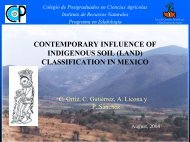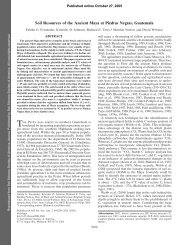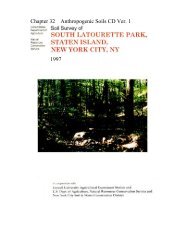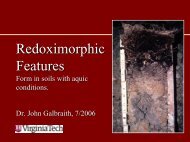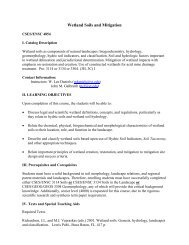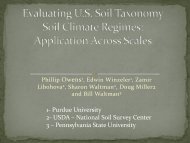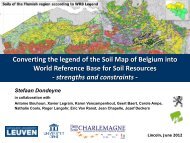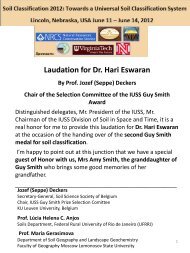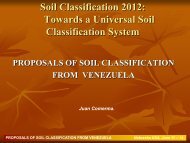Nebraska Soils Field Trip - Virginia Tech
Nebraska Soils Field Trip - Virginia Tech
Nebraska Soils Field Trip - Virginia Tech
Create successful ePaper yourself
Turn your PDF publications into a flip-book with our unique Google optimized e-Paper software.
4th IUSS Soil Classification Conference <strong>Field</strong> Tour Guidebook<br />
Nearly all of this area is farmland, and about two-thirds is cropland. The cropland is more extensive on<br />
the less sloping soils that formed in loess than on other soils. Wheat and corn are important cash crops,<br />
but grain sorghum, soybeans, and alfalfa and other hay crops are grown on a large percentage of the<br />
area. Most of the grain and hay is fed to livestock on the farms where it is grown. About one-fourth of the<br />
area is used as pasture or range. Pastures of native grasses are more extensive on the strongly sloping<br />
to steep soils that formed in glacial till than on other soils. Pastures of introduced grasses and legumes<br />
are on the more productive soils, and native grasses are common on the more sloping, shallow soils.<br />
Native woodland is confined to narrow bands bordering drainageways and streams and to some nearly<br />
level, wet soils on bottomland.<br />
The major soil resource concerns are water erosion and maintenance of the content of organic matter in<br />
the soils. The resource concerns on pasture and rangeland are plant productivity, health, and vigor;<br />
noxious and invasive plants; and inadequate wildlife habitat. Conservation practices on cropland<br />
generally include high-residue crops in the cropping system, systems of crop residue management (such<br />
as no-till, strip-till, and mulch-till systems), gradient terraces and grassed waterways, underground outlets,<br />
contour farming, conservation crop rotations, and nutrient and pest management.<br />
Conservation practices on rangeland and pasture generally include prescribed grazing, brush<br />
management, management of upland wildlife habitat, and proper distribution of watering.<br />
107B—Iowa and Missouri Deep Loess Hills<br />
This area is in Iowa (53 percent), Missouri (32 percent), <strong>Nebraska</strong> (12 percent), and Kansas (3 percent). It<br />
makes up about 14,410 square miles (37,335 square kilometers). It includes the cities or towns of<br />
Atlantic, Council Bluffs, and Sioux City, Iowa; St. Joseph, Kansas City, Independence, and Marshall,<br />
Missouri; Atchison, Leavenworth, and Kansas City, Kansas; and Omaha, <strong>Nebraska</strong>. Interstates 29, 35,<br />
70, and 80 cross different parts of this area. Fort Leavenworth Military Reservation and parts of the<br />
Winnebago and Omaha Indian Reservations are in this MLRA. A number of State parks are throughout<br />
the area, and a number of national wildlife refuges are in the area, especially along the Missouri River.<br />
Location of MLRA 107B in Land Resource Region M<br />
23<br />
Physiography<br />
This area is almost entirely in the Dissected Till<br />
Plains Section of the Central Lowland Province<br />
of the Interior Plains. The farthest southern part<br />
of the area in Missouri is in the Osage Plains<br />
Section of the same province and division.<br />
Slopes are mostly rolling to hilly, but some<br />
broad ridgetops are nearly level to undulating.<br />
Slopes bordering the major stream valleys are<br />
steep. Nearly level, broad valley floors are along<br />
a few large rivers. Elevation ranges from 600<br />
feet (185 meters) where the Missouri River exits<br />
the area to 1,565 feet (475 meters) on the<br />
highest ridges. Local relief is mainly 10 to 100<br />
feet (3 to 30 meters), but valley floors can be 80<br />
to 300 feet (25 to 90 meters) below the adjacent<br />
uplands. Also, some upland flats and valley<br />
floors have local relief of only 3 to 6 feet (1 to 2<br />
meters).





